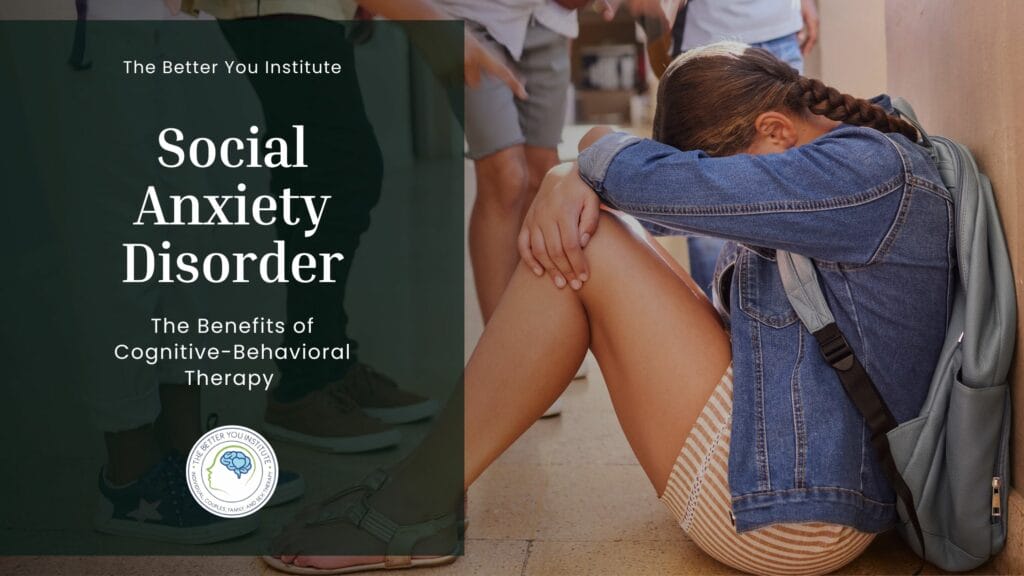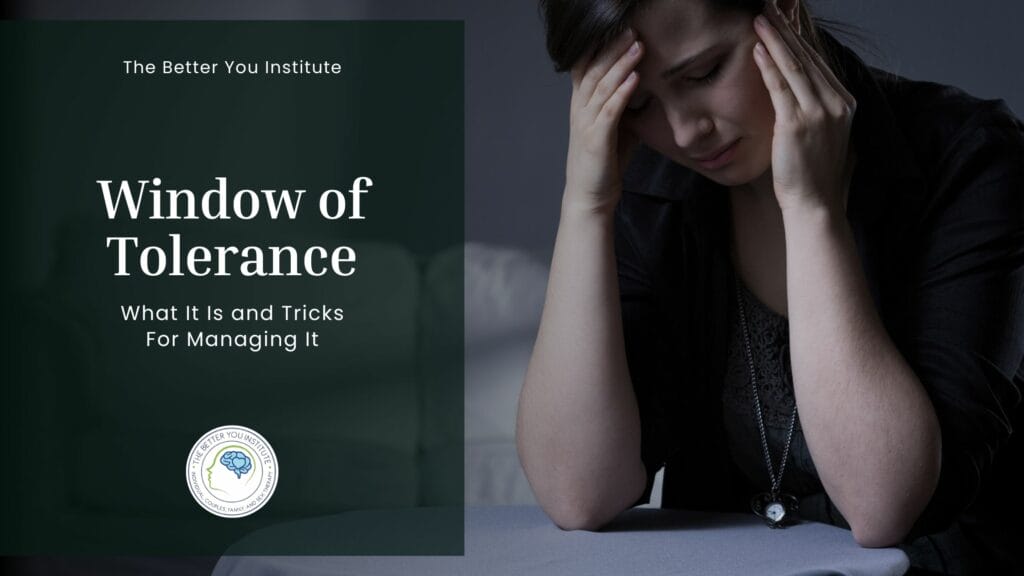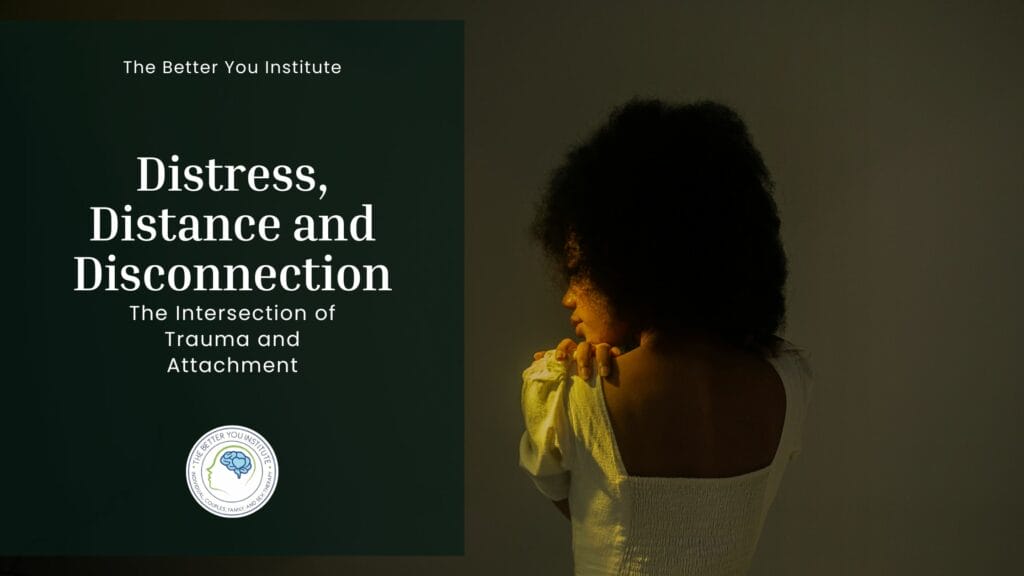Social Anxiety Disorder (SAD), also known as social phobia, is a form of anxiety. It is defined as the intense fear of being watched or judged by others. This intense fear occurs in most or all social situations, such as meeting new people, being around many people at once, and speaking in front of a large group. It can also happen in what is considered to be everyday activities, such as talking with co-workers, going to the grocery store, or eating in public. Social Anxiety Disorder can hinder everyday life due to the fear of humiliation and rejection. Interestingly, social anxiety is most prevalent in females. Furthermore, the symptoms of social anxiety disorder often begin in childhood and adolescence. This article will examine cognitive behavioral therapy and how CBT for Social Anxiety Disorder can be applied.
Table of Contents
What is Social Anxiety Disorder
Social anxiety derives from a fear of being watched or judged by others. According to the diagnostic manual that therapists, psychologists, and psychiatrists use to diagnose their clients, the criteria of Social Anxiety Disorder include fear or anxiety about one or more social situations in which the individual is exposed to possible scrutiny by others. The individual fears anxiety symptoms will be negatively evaluated, leading to rejection. Another criterion is that social situations almost always provoke fear and anxiety. Also, the fear of anxiety leads to avoidance, and the perceived threat exceeds the actual threat. Anxiety occurs in social situations involving peers or adults in children and adolescents. Social anxiety disorder’s physical symptoms include nausea, rapid heart rate, little to no eye contact with others, rigid posture or closed-off stance, avoidance, sweating, and trembling.
Behavioral Attributes of Social Anxiety Disorder
Individuals with social anxiety disorder are typically reserved when meeting new people, are quiet in groups, and/or are withdrawn in unfamiliar or uncomfortable social settings. When interacting with others, they might show discomfort, such as not making eye contact, but experience intense emotional and physical symptoms. Some physical symptoms include heart racing, sweating, trembling, and trouble concentrating.
Individuals with SAD often desire interactions with others but avoid social situations due to fear of being viewed negatively. As a result, they avoid speaking in public, expressing their opinions, or even conversing with peers. People with social anxiety disorder often exhibit low self-esteem and high self-criticism. This could result from pressure to succeed from caregivers with little to no positive reinforcement of accomplishments.
Cognitive Attributes of Social Anxiety Disorder
Social Anxiety Disorder involves heightened monitoring of a perceived external threat, in-situation safety behaviors, event avoidance, and post-event rumination, which can be labeled as self-focused cognitive processes. Self-focused cognitive processes are vital to maintaining anxiety experienced in social and performance situations. Individuals might also analyze another individual’s mental self-representation and correlate it to the audience’s expected standard. Furthermore, individuals may also judge the probability and consequence of negative evaluation. Researchers suggested that socially anxious individuals engage in self-focused cognition before, during, and after social situations.
Social Contexts
Numerous factors can contribute to the onset and symptoms of social anxiety disorder. Two main factors include age and socioeconomic status. Unfortunately, there has not been enough research, yet, that reflects the impact of race on social anxiety disorder.
Age
Social anxiety is a disorder that typically originates in adolescence. Longitudinal studies have shown that it is unusual for individuals to develop SAD in early childhood. Instead, in most cases, individuals begin to have symptoms at or close to 13 years old. According to Erik Erikson, the ‘identity vs. confusion’ stage is twelve. In this stage, adolescents begin to form their identity and independence from their caregivers. Early adolescents prioritize their social life, leaving peer pressure to play a significant role. Adolescents in this stage often want to be accepted by peers, and rejection often leads to low self-esteem. Adolescence is when individuals move from dependence on caregivers to learning how to engage with peers in a manner that will shape their identity. They become more autonomous from their caregivers and reliant instead upon the support and validation of their peer groups.
A 2007 study compared social anxiety disorders in children and adolescents. The study was conducted with 74 children (ages 7-12) and 76 adolescents (ages 13-17) with a primary diagnosis of Social Anxiety Disorder. Using interviews, recordings, questionnaires, and checklists, the study involved parental reports and self-reports of the children and adolescents. Adolescents share many features of social anxiety disorder with children but have a more distinct pattern of social dysfunction and might be more functionally impaired. The study also demonstrated that social anxiety disorder is linked to emotional, social, and academic impairment.
Socioeconomic Status (SES)
Researchers have found that individuals with social anxiety disorder are more likely to be less educated, unmarried, and of lower socioeconomic status. However, socioeconomic status is not a determining factor of social anxiety disorder. More research needs to be conducted on the impact of socioeconomic status on Social Anxiety disorder to gain a more concrete understanding of how SES impacts SAD.
Applied CBT for Social Anxiety Disorder
Research shows that Cognitive-behavioral therapy (CBT) is one of the most beneficial forms of treatment for social anxiety disorder. It helps manage thoughts and physical symptoms associated with social anxiety disorder. More specifically, exposure therapy focusing on directly facing fear has been the most effective in treating SAD. Exposure therapy helps people learn coping skills and realize they can conquer their anxiety over time.
Cognitive-behavioral therapy is a short-term, present-oriented approach to psychotherapy that teaches individuals the cognitive and behavioral necessities to function in their interpersonal and intrapersonal settings. The specific treatments within CBT that have been applied to the treatment of Social Anxiety Disorder are cognitive restructuring, exposure, relaxation training, and social skills training.
Cognitive Restructuring
Individuals with SAD need to examine their thoughts about feared situations and identify the core beliefs and causes. Researchers believe that it arises from false beliefs, otherwise known as cognitive distortions, about the potential dangers that social situations might lead to, pessimistic predictions about the outcomes of these situations, and biased processing of events that transpire during social situations. To best overcome these cognitive distortions, a person must participate in cognitive restructuring.
There are three different factors that individuals are taught in the cognitive restructuring of cognitive distortions: Identify negative thoughts before, during, and after the anxiety-provoking situation. The second is to evaluate the accuracy of these thoughts. Lastly, individuals must create rational alternative thoughts based on the previous steps.
Exposure
Exposure techniques aid clients in facing situations that they perceive as fearful. Exposure also helps individuals stay mentally engaged in the natural conditioning processes involved in fear reduction. There are a few different ways one might expose themself to the very thing they are fearful of. One way is seeking psychotherapy, where the client and therapist develop the ‘hierarchy of fear’ charts. The hierarchy chart is a rank-ordered list of anxiety-provoking situations. This chart keeps anxiety in a tolerable range. The client then starts working on the least feared situation and building up to the more complex situations. Clients need to allow themselves to be fully engaged in the feared situation by paying full attention to the details of it, experiencing it thoroughly, and allowing anxiety symptoms to occur. Clients often feel a sense of accomplishment when less fearful situations are achieved. The client’s symptoms and fears gradually subside with imagination, role play, or addressing anxiety-provoking situations outside sessions.
Relaxation Training
Relaxation training guides clients through exercises involving different muscle groups. The therapist helps the client learn and practice relaxation during the session and encourages the client to practice them at home. The goal is for clients to notice the difference between tension and relaxation and acknowledge the sensations associated with relaxation, such as positivity or relief. Clients also learn to scan their bodies for muscle tension and release any tension by recalling how those muscles felt when relaxed. Relaxation for social anxiety disorder is typically ineffective unless applied outside sessions when the client feels anxious. Relaxation is effective for adolescents when combined with other forms of treatment, such as exposure.
Social Skills Training
Individuals with SAD often exhibit communication deficiencies in social settings, such as poor eye contact and conversation skills. Verbal and nonverbal language difficulties characterize social communication deficits for social purposes. These difficulties can be seen in social interactions, understanding, and pragmatics. These deficiencies invoke adverse reactions from others, which causes social interactions to be anxiety-provoking. Researchers conducted a study with parents of 404 children. Half of the children had Social Anxiety Disorder (SAD), and the other half had Generalized Anxiety Disorder (GAD). The parents of these children completed a social communication questionnaire. The data collected from parents was used to compare the kids with social anxiety disorder and generalized anxiety disorder. Repetitive, restrictive, and stereotyped behaviors were measured. The study concluded that social communication training would benefit children with social anxiety disorder.
Social skills training may provide benefits because of the training aspects, the exposure aspects, or the cognitive elements. Common social skills training techniques include therapist modeling, behavioral rehearsal, corrective feedback, social reinforcement, and homework assignments that allow the individual to practice these things in the comforts of their own home. Social skills training may also be easily combined with other techniques, such as cognitive restructuring or exposure. Social skills training is most beneficial for adolescents as it can boost self-esteem and aid them in having the proper communication skills before they reach adulthood.
Social anxiety disorder, an intense fear of social situations, would be most beneficial when using cognitive behavioral therapy to treat. Some factors contributing to Social Anxiety Disorder are gender, age, and socioeconomic status. Further research should be conducted to determine how social anxiety disorder connects to race. Furthermore, the extent to which social communication deficit impacts adolescents with social anxiety disorder should be researched. The current research stresses the importance of screening or being aware of social anxiety disorder in childhood before reaching adolescence, in which the symptoms and effects can be severe. If you or your adolescent is suffering from a social anxiety disorder, reach out to us today to get help from a trained professional. 267-495-4951.







